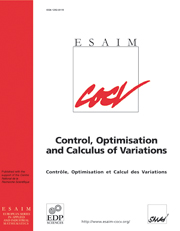Article contents
Eliciting harmonics on strings
Published online by Cambridge University Press: 18 January 2008
Abstract
One may produce the qth harmonic of a string of length π by
applying the 'correct touch' at the node $\pi/q$ during a simultaneous pluck or bow. This notion was
made precise by a model of Bamberger, Rauch and Taylor. Their 'touch' is
a damper of magnitude b concentrated at $\pi/q$
during a simultaneous pluck or bow. This notion was
made precise by a model of Bamberger, Rauch and Taylor. Their 'touch' is
a damper of magnitude b concentrated at $\pi/q$ .
The 'correct touch' is that b for which the modes, that do not vanish
at $\pi/q$
.
The 'correct touch' is that b for which the modes, that do not vanish
at $\pi/q$ , are maximally damped. We here examine the associated spectral
problem. We find the spectrum to be periodic and determined by a polynomial
of degree $q-1$
, are maximally damped. We here examine the associated spectral
problem. We find the spectrum to be periodic and determined by a polynomial
of degree $q-1$ . We establish lower and upper bounds on the spectral abscissa
and show that the set of associated root vectors constitutes a Riesz basis
and so identify 'correct touch' with the b that minimizes the spectral
abscissa.
. We establish lower and upper bounds on the spectral abscissa
and show that the set of associated root vectors constitutes a Riesz basis
and so identify 'correct touch' with the b that minimizes the spectral
abscissa.
- Type
- Research Article
- Information
- ESAIM: Control, Optimisation and Calculus of Variations , Volume 14 , Issue 4 , October 2008 , pp. 657 - 677
- Copyright
- © EDP Sciences, SMAI, 2008
References
- 3
- Cited by




